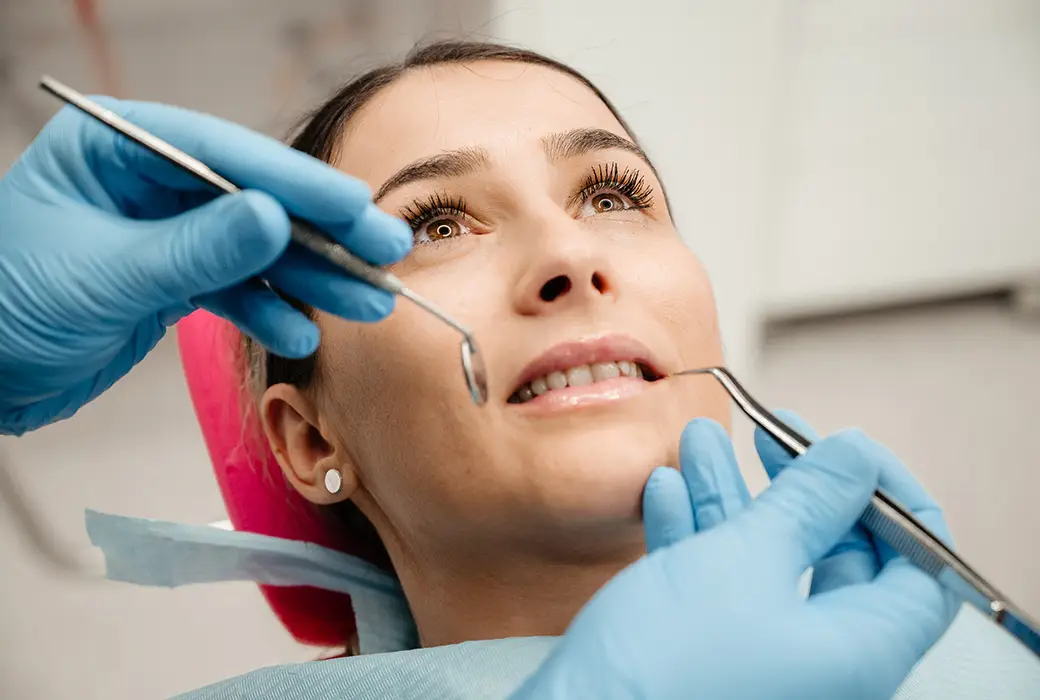
Oral cancer
What is it, how is it detected, and how is it treated?
Known also as buccal cancer or oral malignant tumor, oral cancer manifests as a swelling or lesion of the oral mucosa that does not heal, caused by the uncontrolled growth and division of cells. According to Dent Estet specialist Vanda Popa, Ph.D. in Medical Sciences and specialist in Periodontology, oral cancer can appear in various locations within the oral cavity. It can be detected on the surface, edges, or dorsal part of the tongue, inside the cheeks, on the hard or soft palate of the mouth, on the upper lip, as well as on the gums or inside the jaws. The symptoms of this type of cancer are not visible to the naked eye in the early stages, and its spread is rarely associated with acute pain.
What types of oral cancer are there?
Detected at the medical office, sometimes even during dental treatments, oral cancer can occur in men and women of any age, but especially in people over 45 years old.
Carcinoma
One of the most commonly encountered types of cancer is squamous cell carcinoma. In this case, the flat cells that normally line the inside of the cheeks, tongue, gums, palate, and throat exhibit an abnormal appearance. Most often, this cancer affects men aged between 55 and 65 years, as well as women aged between 50 and 75 years.
Adenocarcinoma
Formed in the glands that secrete substances inside or outside the body, oral adenocarcinoma primarily affects the minor salivary glands that cover the mouth and throat.
Sarcoma
Approximately 80% of these malignant tumors are detected in soft tissues. Developed in the submucosa of the oral cavity, this variation of malignant tumors is also known as Kaposi's sarcoma. Found in elderly individuals, especially males, sarcoma has a slow progression that can extend up to 15 years. The presence of the HIV virus in the body is a factor that favors the occurrence of this type of cancer.
Melanoma
Located in the cells that produce skin pigment, also known as melanocytes, this type of cancer manifests as dark, swollen malignant lesions that can sometimes be accompanied by bleeding.
Lymphoma
Although this cancer usually appears in cells within the lymph nodes, it can also be found in the oral cavity. Developed in lymphatic tissues, these oral cancers also affect other areas with lymphoid tissue, such as the tonsils and the base of the tongue.
What are the causes of this condition?
Twice as common in men as in women, oral or oropharyngeal cancer typically occurs at an average age of 62. Two-thirds of individuals affected by this serious condition are over 55 years old. The causes leading to oral cancer include both lifestyle influences and genetic inheritance.
Predispositions
Fanconi anemia is a blood disorder caused by congenital anomalies, which can lead to leukemia or aplastic anemia. The risk of oral cancer for a person with Fanconi anemia is up to 500 times higher than normal. Dyskeratosis congenita is another genetic syndrome that can cause aplastic anemia and may lead to oral cancers from an early age.
Smoking
The habit of smoking cigarettes, cigars, and even pipe tobacco is harmful not only to the lungs but also to the health of the tissues in the oral cavity. The immediate effect of smoking is decreased immunity and slower recovery after surgical intervention. The larynx, throat, esophagus, as well as the membranes lining the tongue, throat, and lips, are 50% more exposed to cancer in smokers.
Excessive Alcohol Consumption
Reducing or eliminating alcohol consumption from your lifestyle is one of the factors that reduce the risk of oral cancer. Ethanol and acetaldehyde in alcohol have a direct effect on the development of cancer cells in the tissues of the oral cavity.
Unbalanced Diet
A lack of a diverse, healthy, and balanced diet is one of the risk factors that favor the appearance of oral cancer. Including a variety of fruits and vegetables in your diet, as well as avoiding highly processed foods, is a simple way to reduce the risk of oral cancer.
Prolonged Sun Exposure
Excessive time spent in strong sunlight is one of the most dangerous risk factors for oral cancer. The incidence of lip lesions is higher in younger people.
Papilloma Virus
The human papilloma virus (HPV) affects the skin and the moist membranes lining the organs, oral cavity, and throat. HPV infection, which can be transmitted through normal or oral sexual contact, as well as skin contact, causes uncontrolled cell proliferation in tissues, and is another factor that can cause oral cancer.
Recurrent Oral Mucosal Lesions
Oral cancer can sometimes be caused by persistent wounds on the oral mucosa due to sharp edges of damaged teeth or imperfect dentures.
Signs and symptoms indicating the presence of oral cancer
Some signs indicating the appearance of a form of oral cancer include:
- sores that do not heal;
- persistent pain that does not improve;
- bad breath;
- tooth loss;
- swelling or inflammation of the lips;
- difficulty or pain when swallowing;
- bleeding or numbness in the mouth;
- difficulty speaking;
- sudden weight loss.
Available detection methods
In fortunate cases, many symptoms of oral cancer can indicate other, less serious conditions. For a clear diagnosis, it is recommended to have a check-up at least once a year. Early detection of oral cancer can increase the survival rate by approximately 80%.

Physical Examination
The Oral Cancer Screening test can detect oral cancer in its early stages in just three minutes. The procedure, based on the use of Sapphire Plus Lesion Detection and Velscope VX lamps, is non-invasive, quick, and painless. The dentist examines the oral cavity using a device equipped with a built-in digital camera, which provides a detailed image and allows for an in-depth scan of all areas that might contain precancerous or cancerous cells that are not visible to the naked eye. The technologies used by these lamps help detect infections, abnormalities, and tumors in the oral cavity and mucosa. The oral cancer screening also includes an additional clinical examination performed by the dentist.
Biopsy
If symptoms indicating oral cancer are present in a tissue area, samples will be taken. The specialist doctor will send the tissue sample to a test laboratory for a biopsy. The procedure, based on the microscopic analysis of suspicious cells, reveals any cancerous and precancerous changes that may occur.
Blood tests
Immunoelectrophoresis is helpful in detecting abnormalities in immunoglobulins, and tests for tumor markers can reveal the presence of oral cancer. The results of these types of analyses must be interpreted carefully, and their accuracy varies depending on the patient's current state and diet during the test period.
Imaging tests
Using conventional X-rays, CT scans, MRIs, and positron emission tomography (PET) scans, the specialist doctor can determine the extent of the spread of cancer cells on the surface of the oral cavity.
What treatment Is applied in the case of oral cancer?
If tests confirm the presence of oral cancer, treatment for this condition should be provided in accordance with the recommendations of a specialist. The most commonly used methods include:
Surgical Interventions: This procedure removes the tumor along with a portion of the surrounding tissue. Some people may require repeated surgeries, depending on the stage of the tumors and their location.
Radiotherapy: Complementary to surgical interventions, radiotherapy involves external irradiation with high-energy X-rays or protons. Internal irradiation uses a radioactive implant placed in the targeted tissues affected by cancer. Regardless of the type of radiotherapy, it involves side effects such as difficulties in speaking and chewing, hearing loss, hypothyroidism, and other similar manifestations.
Chemotherapy: For advanced cancers, chemotherapy is administered before surgery or radiotherapy over several months. The drugs used in the treatment are administered orally or by injection, and they work by slowing down or even blocking the development of cancer cells.
Statistics and prognosis
Oral cancer is among the top oncological diseases causing fatalities worldwide. The most severely affected parts of the body are the lips, gums, tongue, and palate. According to an analysis by the National Center for Health Evaluation and Promotion, Europe accounts for 23.4% of cancer cases worldwide and 20.3% of cancer deaths, despite having only 9.0% of the global population. Nationally, the estimated number of cancer-related deaths is 50,902 people, but at least one-third of the most common cancers can be prevented.
What preventive measures can be applied?
The grim prospect of cancer is reason enough for major lifestyle changes. If you are unsure where to start to minimize the risks of such a disease, you can follow a few simple steps:
- Quit smoking to stop the effects of chemical compounds on the cells of the oral cavity;
- Adopt moderate alcohol consumption to reduce irritation of the mouth's cells;
- Include fruits and vegetables in your diet for a constant dose of antioxidants;
- Avoid excessive sun exposure and protect your lips with a lip balm that has sun protection factor;
- Visit the dentist regularly for early detection of cancerous lesions.
Regardless of the ferocity of an apparently incurable disease, proper prophylactic measures help drastically reduce the risks. Modern technology and specialists who are constantly up to date with innovations in the medical world are a true guarantee of a predictable state of health.


